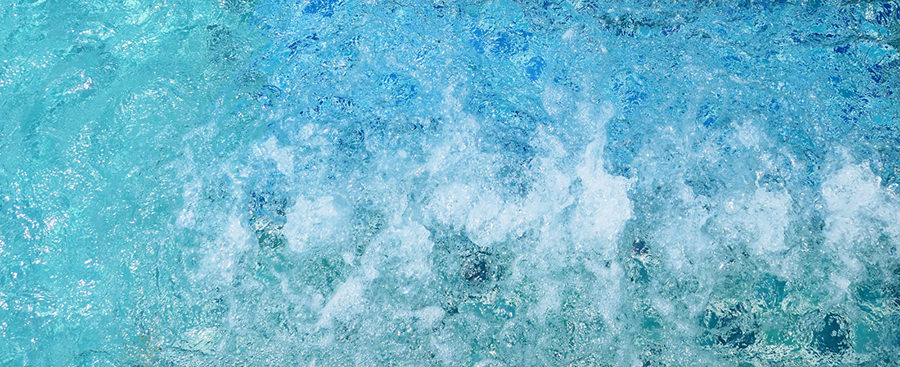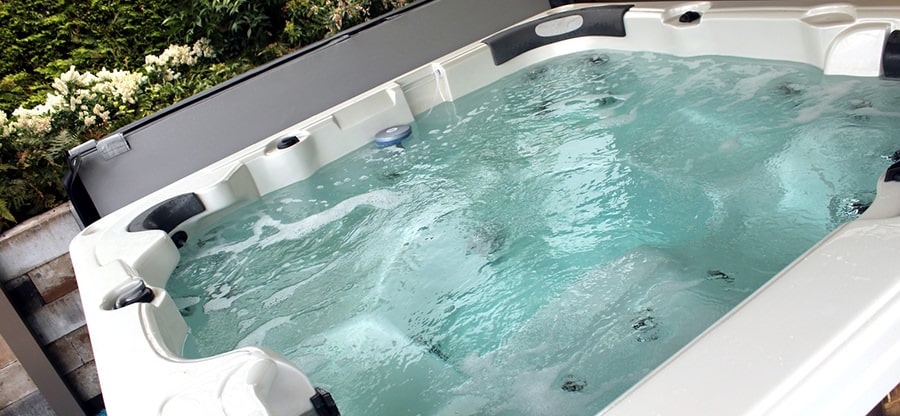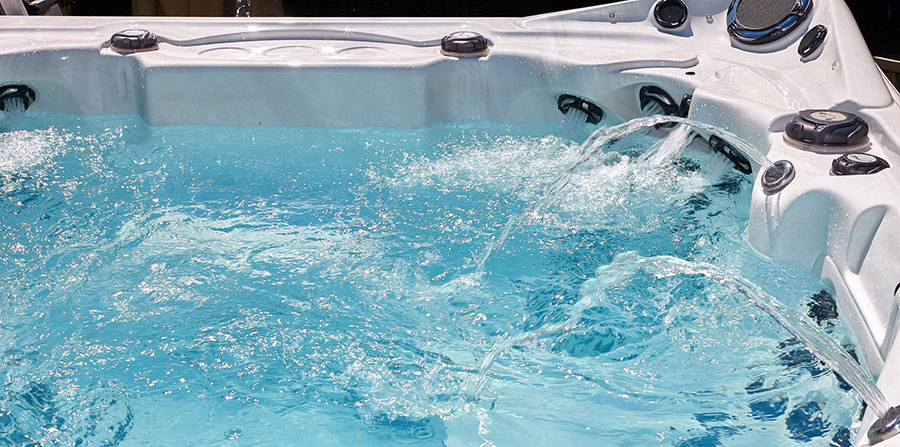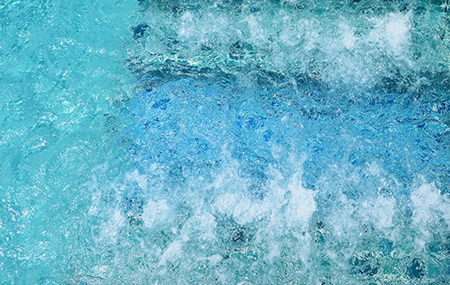
Luxuriating in your hot tub is all well and good but, unfortunately, you do need to make the effort to drain the water and refill it on a regular basis to maintain levels of cleanliness and keep the water in tip-top condition. I wasn’t exactly sure how often I needed to change the water in my hot tub so I decided to investigate.
So, how often should you change the water in your hot tub? On average the water in most hot tubs should be changed every 3 months. If your hot tub is heavily used you may need to change the water more frequently or, if it only gets light use, then the water might be fine for a little longer than the 3-month average.
In many ways, it’s a difficult thing to get right because, to be honest, changing the water in your hot tub is a bit of a pain! It also costs money in terms of the actual volume of water you use (assuming that you are on a water meter and pay by the quantity of water you use) and also in terms of the energy you will use bringing such a large body of water up to the correct temperature. So, you don’t want to be changing it more often than you need to. Similarly, if you let it go too long then you run a significant risk of harmful bacteria multiplying in your hot tub. At best this will just make the water less pleasant to be in but, in the worst case scenario, this could lead to an increased risk to you and your family’s health.
Why do I need to change my hot tub water?
Pure clear water, on it’s own, doesn’t cloud, go off or degrade. Actually, if you filled your hot tub and then kept the lid on to keep any debris out and you didn’t actually use it then you could happily go for months or even a year or more without changing the water. The problems occur when we start introducing other things into the water like chemicals. Yes, of course, chemicals purify, sanitize and clean the water, but they also leave behind unwanted byproducts that stick around in the water and slowly clog it up.
However, the biggest enemy of pure fresh hot tub water is that of our filthy bodies! Even if we shower before entering the hot tub we still bring with us makeup, perfume, shampoo, moisturiser, deodorant etc etc etc not to mention a healthy dose of good old dirt and bacteria, dead skin and, according to one scientific study, a measurable and predictable amount of faeces.
Yuk!
If you imagine this little cocktail of grime being shaken around with all of the movement and jets of water in the hot tub then you can see why problems develop. Add to this the relatively small volume of water per human and the high temperature of between 37 and 40 degrees C and you can see how hard it is to keep your water anything like pure and clear for very long!
Now, of course, the chemicals, filtration and purification system will be able to help keep things clear for a while. But eventually, the tiny little particles of dirt and chemicals add up to the point where the water is completely saturated with them and this is when you start to have problems. The saturation point is where a liquid can’t dissolve any more of a solid in it – it becomes completely saturated. You might remember spooning salt or sugar into water in school science lessons? Basically, you keep going spooning the salt into the water until it will no longer dissolve and the salt just sits in the water at the bottom of the container.
It’s exactly the same with hot tub water in that it becomes completely laden and saturated with debris that it’s impossible to recover the water quality without replacing it and starting again.

But why can’t you just add more chemicals to sort the water out?
Good question. You would assume that if you added more sanitizer to the water it would just blast the bad bits and the water would clear. It’s all to do with something called TDS or total dissolved solids. In relatively new, clear water it’s easy for the cleaning chemical to find the bacteria, grab hold of it and destroy it. It’s a bit like playing paintball in a lightly wooded park – it’s easy to see your target and you stand a good chance of blasting them without too many problems. Now, as the water gets increasingly clogged with undissolved solids and particularly organic matter from our bodies then it becomes much harder for the cleaning chemical to find it’s target. The water is so cluttered that actually attaching to and destroying the bacteria is considerably harder. A bit like paintballing in thick dark woodland!
Remember that we are talking about all of this happening at microscopic levels. Your hot tub filtration system will filter out larger particles and dirt but the level that this is happening at is absolutely tiny. Once your TDS level gets to around 1500 parts per million then it’s time to change the water. It will vary a little bit based on the exact make up of the non dissolved solids but this is a good benchmark. Luckily, it’s easy to test your TDS level and it only takes a few moments with TDS test strips that are easily and inexpensively available.
What effects the frequency that I need to change the water?
Initial water quality – There’s not really that much that you can do to change the water quality from your household supply. However, it can be quite useful to know what sort of water you have and what effect that type of water might be having on your hot tub. The quality of the water will have an effect on the amount of time you can go before actually changing the water in a hot tub and also it might have an effect over a longer period of time on the working parts of your hot tub as well.
The main problem for hot tubs occurs when you live in an area with what’s called “hard” water. This type of water contains a number of minerals including magnesium and calcium. Magnesium and particularly calcium can cause problems in that the calcium can build up inside the internal working parts of your hot tub over time and also having mineral deposits in your water means that the water becomes saturated more quickly. In real terms, this can mean that if you live in a very hard water area you might need to change your hot tub water more frequently. Hot tub owners in “soft” water areas have fewer issues.
Quality and application of chemicals – Using the correct chemicals and applying them regularly and at the right time will mean that your water quality will remain higher for longer. Carefully read the instructions and make sure that you get into a regular maintenance routine of checking the water balancing and adjusting so that you are keeping the water in tip-top condition at all times. As well as this, using high-quality chemicals will make a big difference. Cheaper chemicals tend to leave behind solids, deposits and residues which clog up the water and make it reach saturation point more quickly. If you use high-quality chemicals you will need to use less of them as well
Usage – Bearing in mind that one of the main contaminants of the water in a hot tub is our bodies then obviously the more the hot tub is used the dirtier the water gets and the more frequently it will need to be changed. There’s a simple formula you can use which will give you a rough idea of when to change your water based upon the number of people that you regularly use your hot tub. Take the number of gallons of water that your hot tub holds and divide that number by 3. Then take the number of bathers per day that generally use your hot tub and divide that into that number. This should give you a good guideline, in terms of numbers of days, as to when to change your hot tub water. Obviously, this is only a guideline but it will give you a good starting point
Quality of the filtration system. – The better the filtration system on your hot tub the more contaminants and debris it will remove. As a very general rule, the more expensive and high quality the hot tub and filtration system is the better it will be at keeping the water clean and the longer you will be able to go between changing the water. Some top end hot tub manufacturers even go as far as claiming that you only need to change the water in their hot tubs every year or so. This is great news and, as technology improves and becomes cheaper, these types of filtration systems will filter down into mid-priced and lower price hot tubs as well.
Whatever type of hot tub you own it’s really important to make sure that you keep up with the regular maintenance and change your filters and clean the filtration system as per the manufacturer’s instructions and on a regular basis. This will help keep the water as clean as possible and lengthen the time between water changes being needed.

How do I know when to change the water?
Ok, there are few a few telltale signs that will help you decide when it’s the right time to change the water in your hot tub.
Do a TDS test – One of the most accurate ways of deciding if it’s time to change the water in your hot tub is to do a TDS test. This is quick and simple to do. All you need are TDS test strips and these allow you to see how saturated your water is. The recommended level is no more than 1500 parts per million and anything over this means that your water needs changing.
The water is cloudy – If your water is cloudy you can try adding sanitizer and also clarifier as well as checking that your pH levels are correct. If none of these work, and shocking the hot tub doesn’t have an effect then it’s time to start again to drain the hot tub and add fresh water.
The water is foamy – Again this is another telltale sign that the water needs changing. You can try using foam remover but if this doesn’t work, and the foam is persistent this means that a water change is due.
The water is smelly – This is one of the clearest signs that it’s time to drain the hot tub and to start afresh. Smelly water is incredibly unpleasant and unhygienic if the water in your hot tub smells drain it out and start afresh.
How do I change my hot tub’s water?
Clean the plumbing and jets – It’s a great idea to clean the inner parts of your hot tub at the same time as changing the water. Use a flushing product, add it to the water and then run the pumps on high speed for 20 minutes. This should flush out all the dirt and debris from the internal workings of a hot tub into the water before you drain it.
Drain the water – You can just take out the plug of your hot tub and it will drain or you can use a sump pump to speed the process up. Just be careful that, if you are using a sump pump, you don’t forget to watch the water level and let the pump run dry. On some hot tubs it’s possible to attach a hose to the drain plug so that you can direct the water to where you want it rather than letting it just run all over the place. The water will probably still have chlorine or bromine in it which could be harmful to the plants on your garden and to pets if they drink it so think carefully about where the drained water goes. Remember that in some parts of the world it isn’t permissible to empty your hot tub water into the drains.
Clean the hot tub shell – Use a special hot tub cleaning product follow the instructions and take your time to thoroughly clean the shell of the hot tub. This is time well spent as it’s much more difficult to do a thorough clean when the hot tub is full of water. Take the opportunity to clean around all of the jets in all of the nooks and crannies looking for algae and dirt and, whilst you are at it, check for any possible damage beneath the waterline. Once you have used the product to clean the hot tub, thoroughly rinse the hot tub off to make sure that none of the cleaning product finds its way back into the water when you refill. Spraying down with a garden hose works well and again you can draw off the water using a sump pump.
Clean the filters – You should also clean the filters. There’s little point having clean fresh water being drawn through dirty filters so make sure that you either replace or clean them before refilling with fresh clean water.
Refill with water – Refit the drain plug, pop the garden hose into the hot tub and refill with fresh clean water. Make sure that the hose is completely clean and that no garden grit dust or dirt is getting into the hot tub.
Switch on and add chemicals – Now it’s time to switch the hot tub on and your chemicals and wait until your hot tub’s water has reached the correct temperature before hopping in. It can be a bit time-consuming draining and refilling your hot tub but the pleasure of sitting in fresh clear water is one that’s hard to beat.

What’s a self-cleaning hot tub?
To a certain extent, all hot tubs are self-cleaning. They all have filtration and purifying systems that clean the water constantly so in this respect they are self-cleaning. However, there isn’t really such a thing as a completely self-cleaning hot tub. It’s a term that some hot tub manufacturers have been using as a bit of a marketing ploy. All hot tubs will require some regular maintenance such as checking the water pH levels and cleaning, it’s just that some filtration systems work better than others and therefore reduce the amount of maintenance needed.
There are also some hot tubs that automatically dose the water with sanitizer. This can be useful as it means that you don’t have to remember to do it however you still need to be very careful that the PH level of the water is kept correct and you will also need to check regularly that the right amount of sanitiser is being applied. Even in hot tubs with outstanding filtration and purification systems, it will be necessary to change the water periodically. Some very high-end hot tub manufacturers claim the water in their hot tubs will stay clear for up to a year due to there high quality and efficient filtration systems but you will still need to check and maintain the water on a regular basis.
Related questions
How long does it take to heat up a hot tub from cold? Generally speaking, your hot tub heater will raise the temperature of the water from between 2 and 3 degrees C per hour. So, it all depends on what temperature the water was when it first got into the hot tub! Usually, it’s just best to fill the hot tub and wait for it to fully heat overnight before using it the next day. Make sure that the cover is on to speed up the process and, if you are impatient you can check progress using a floating thermometer.
Can I change my hot tub water in winter? – Yes, but do it all on the same day so there isn’t any risk of water trapped in the hot tub pipes whilst it is empty freezing overnight. It makes sense to choose a warm day if possible and also to keep the hot tub cover on as much as possible during the change as this will keep the heat in. Water won’t freeze whilst it’s moving so don’t allow cold water to sit static in the hot tub once you have refilled it.
What is a partial water change? If you are short of time a partial water change will extend the period of time before you need to do a full change. Simply drain and refill half of the water and this will solve a number of water clarity issues. However, do remember that you shouldn’t skip on doing a full change too often so that you can give the whole tub a proper clean and you can also flush out the plumbing and jets.

